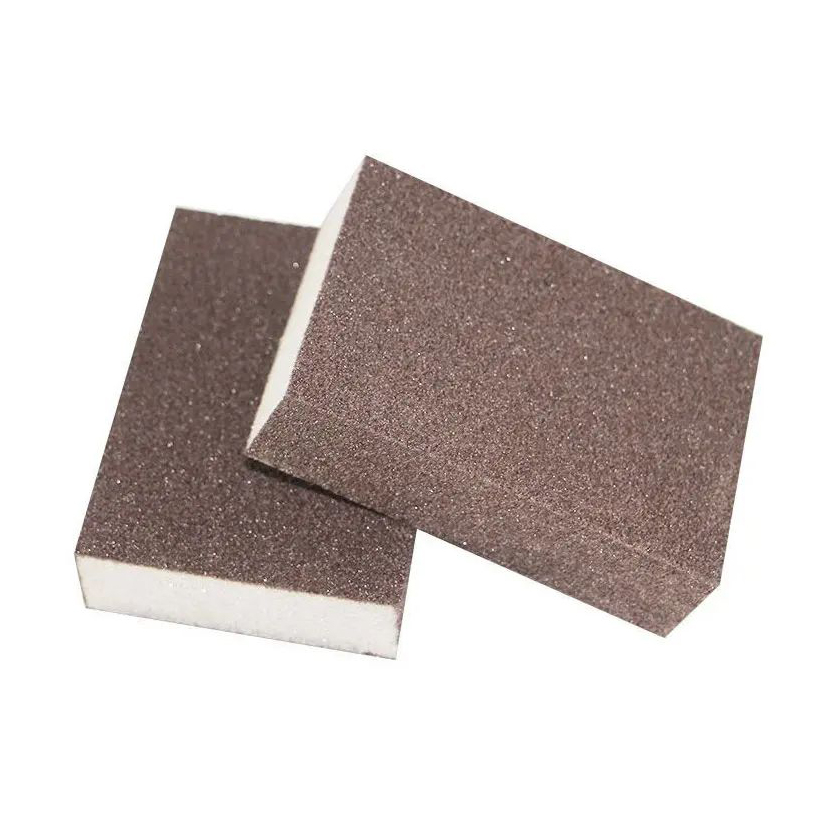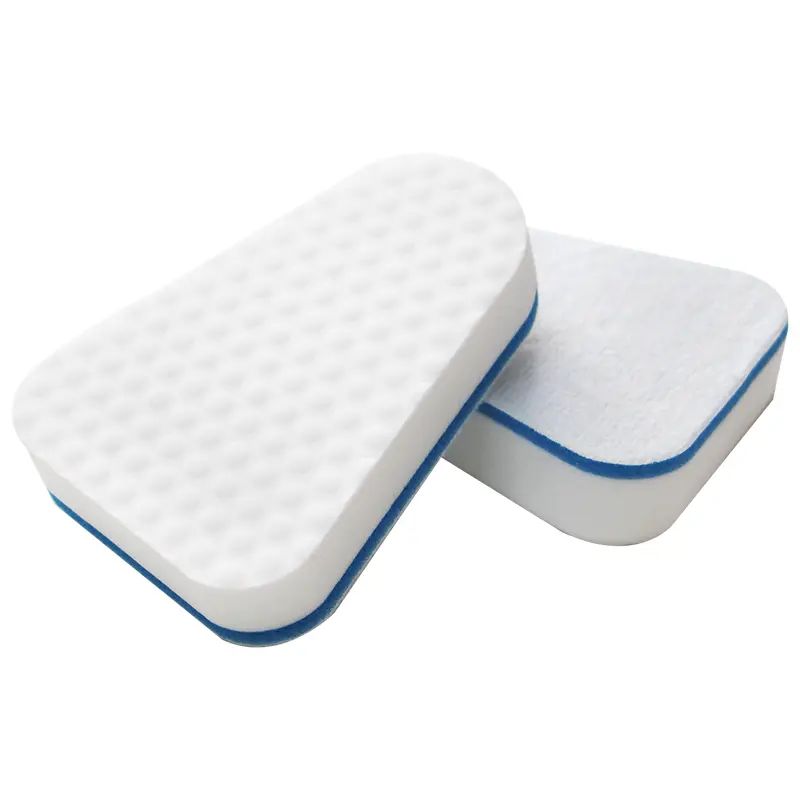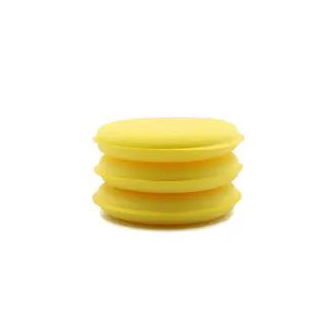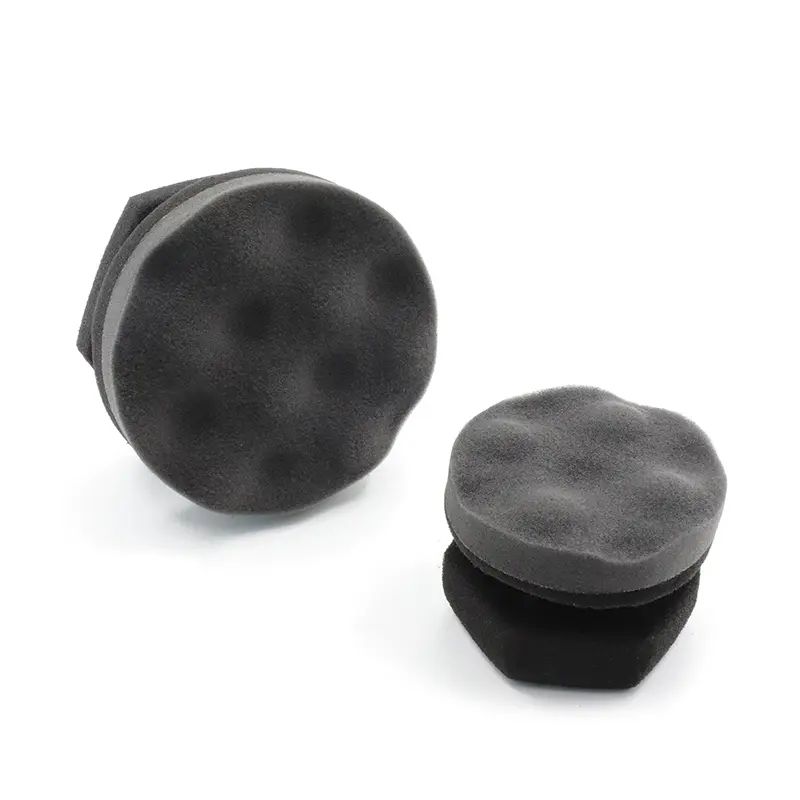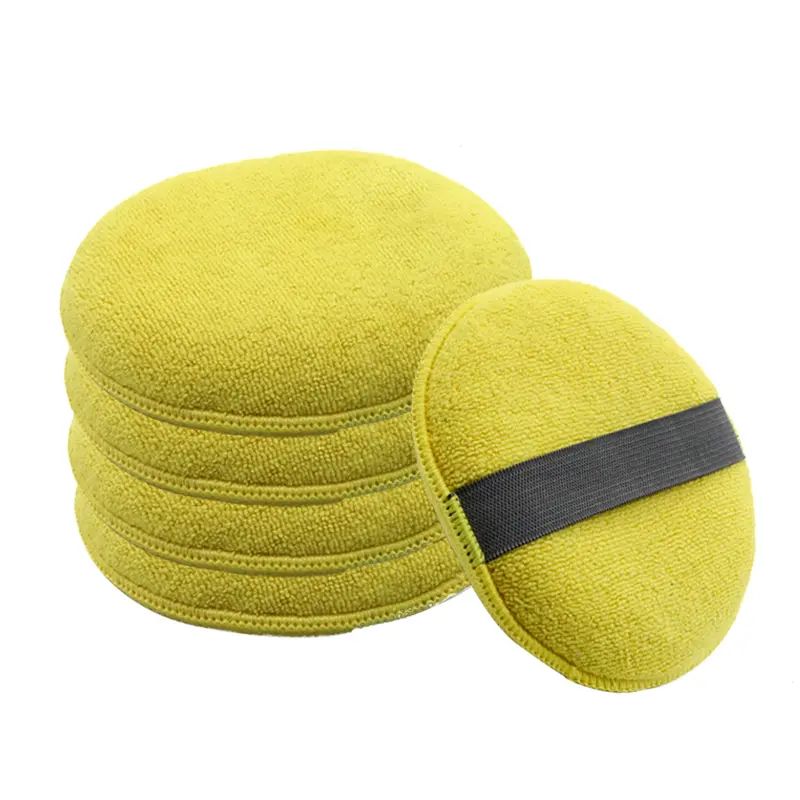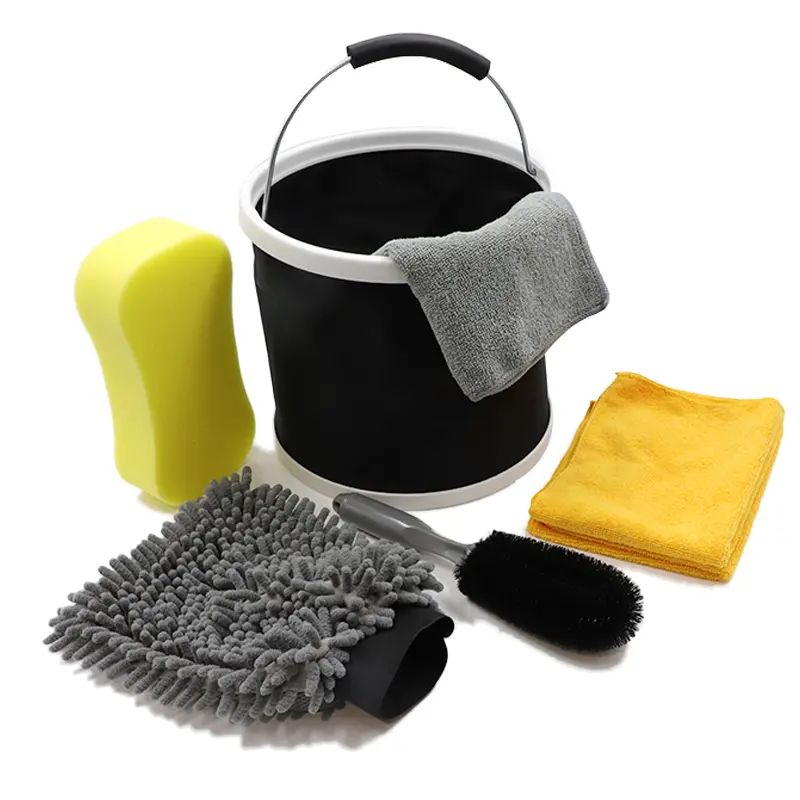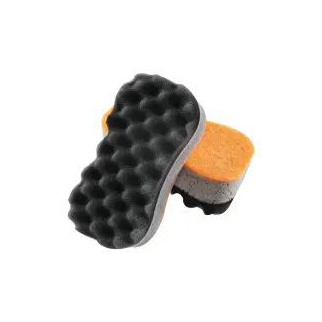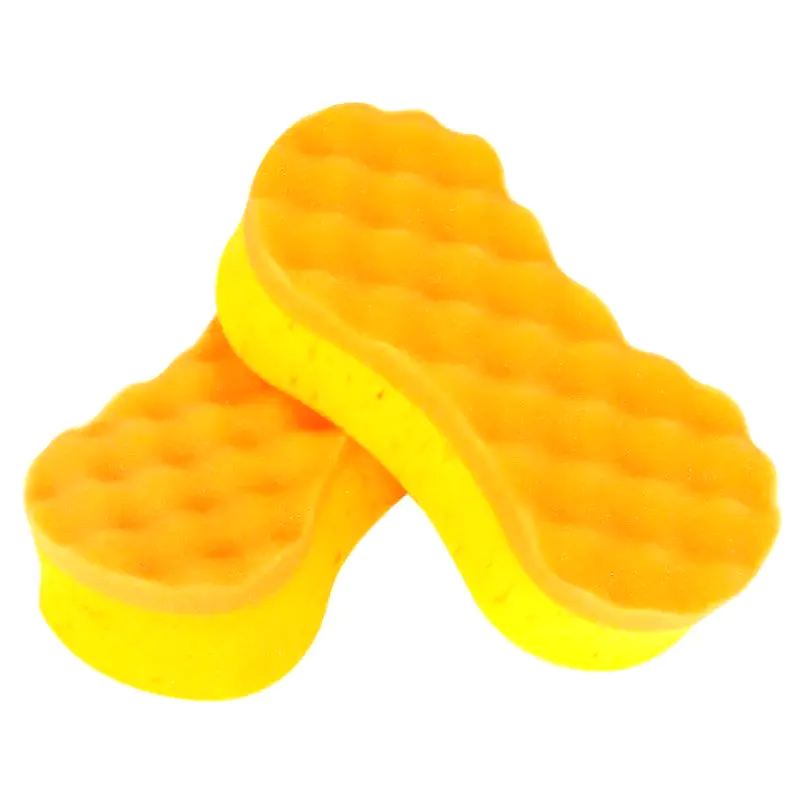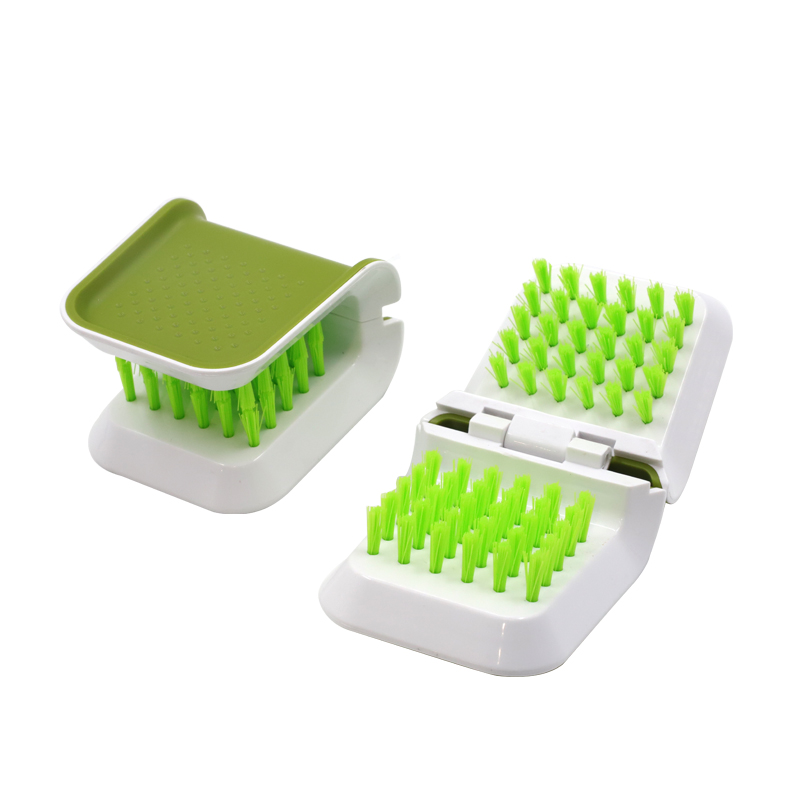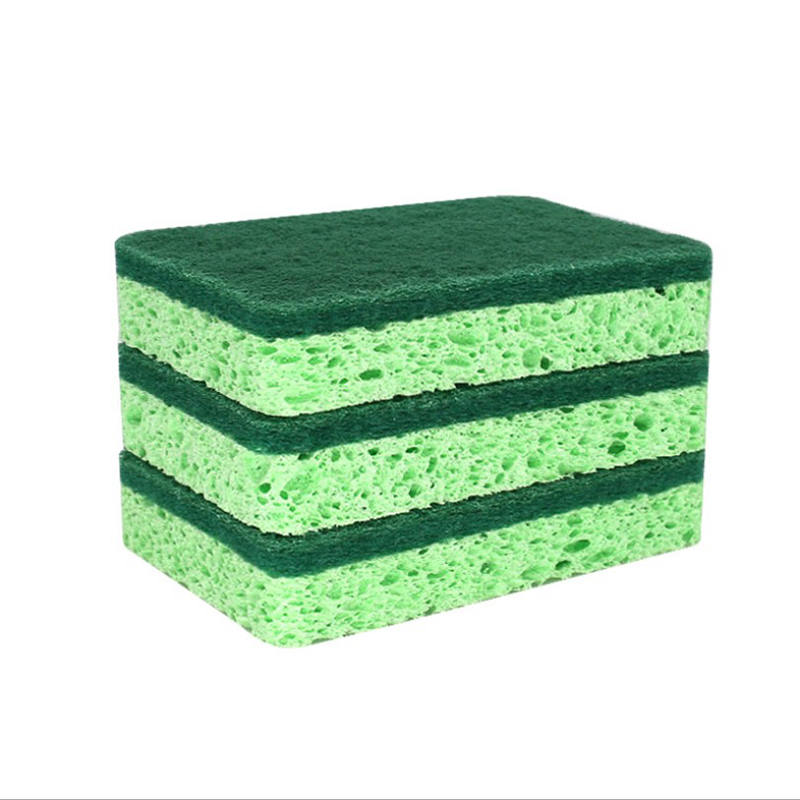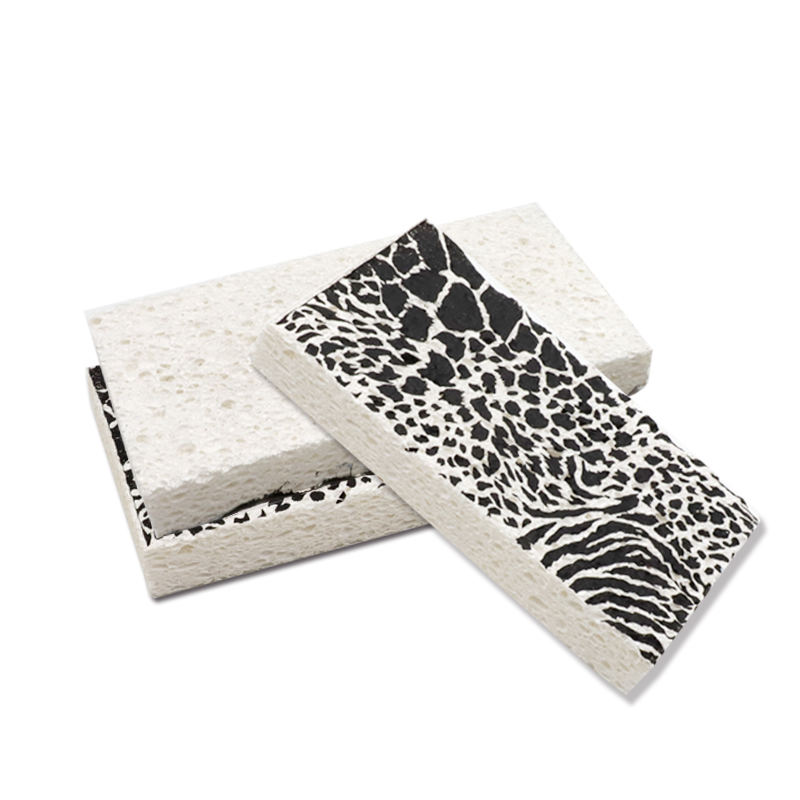What is the difference between a melamine sponge and a regular sponge?
1. Material
Melamine Sponge Material:
A melamine sponge is crafted from a unique and highly specialized foam material derived from melamine resin, which is a type of thermosetting plastic. The distinctive structure of melamine foam is the key to its cleaning power, and here’s why:
Composition and Structure:
Melamine resin is a synthetic polymer made by polymerizing melamine (a nitrogen-rich compound) with formaldehyde. This results in a rigid, hard material that forms the basis for the sponge. During the manufacturing process, the melamine resin is foamed to create a porous, open-cell foam. This foam structure is incredibly fine and has a large surface area, which contributes to its effectiveness.
Microstructure:
The foam's microstructure is often described as "microscopically abrasive." The fine, spongy texture has tiny pores that are capable of scraping off dirt, grime, and stains at a microscopic level. Unlike a typical sponge, which relies on absorption, a melamine sponge essentially works by physically breaking down and lifting debris from surfaces. The porous structure is so delicate that it gently abrades surfaces without leaving scratches in many cases.
Cleaning Effectiveness:
The real "magic" comes from the physical properties of melamine foam. When used to scrub surfaces, the tiny pores of the foam create friction that can break up stubborn dirt and stains. This enables it to erase marks like magic erasers (hence the nickname) by removing stains or discoloration without harsh chemicals. Melamine sponges are often able to reach into crevices and areas that might otherwise be difficult to clean with regular sponges or cloths.
Limitations:
Despite its effectiveness in stain removal, melamine is not absorbent like typical sponges. Its primary role is cleaning through abrasion, not soaking up liquids. This makes it unsuitable for tasks like dishwashing or mopping floors. Because of its fine, abrasive nature, it is generally best suited for non-porous surfaces like ceramic, plastic, or glass, and can sometimes leave scratches on more delicate or glossy finishes.
Regular Sponge Material:
A regular sponge, by contrast, is made from a variety of materials, each with its own unique properties depending on the intended use of the sponge. The most common materials used include:
Cellulose (Natural Sponge):
Composition: Cellulose sponges are made from plant fibers, primarily wood pulp. These sponges are biodegradable and environmentally friendly because they are derived from renewable sources. The cellulose fibers are processed into a sponge-like form through a combination of chemical and mechanical methods.
Structure: Cellulose sponges are highly absorbent due to the cellulose fibers' ability to retain large amounts of water and liquids. The fibers form an open-pore structure, which allows them to hold onto water and cleaning solutions. This makes them ideal for tasks like dishwashing and wiping surfaces where liquid absorption is key.
Properties: Cellulose sponges are relatively soft, making them safe to use on most surfaces without risking scratches. However, they can tear or degrade over time, especially if exposed to excess moisture or rough scrubbing.
Polyurethane (Synthetic Sponge):
Composition: Polyurethane sponges are made from synthetic polymers. The foam is created by introducing gas bubbles into a liquid polymer mixture, which then hardens into a lightweight, spongy material. Polyurethane can be produced in different densities, allowing for a range of sponge types, from soft to highly abrasive.
Structure: Polyurethane sponges typically have a larger and more uniform pore structure compared to cellulose. These sponges are also absorbent and can hold significant amounts of water or detergent. The synthetic nature of the material makes it more durable than cellulose, but it’s less eco-friendly since it is not biodegradable.
Properties: Depending on the density and type of polyurethane foam, these sponges can be soft for delicate surfaces or rough for scrubbing. They're commonly used for general household tasks, such as dishwashing, cleaning countertops, or scrubbing bathrooms. Their structure allows them to pick up dirt and grease but not to break down stains as effectively as melamine.
Other Synthetic Materials:
Sponges can also be made from materials like nylon or polyester (often in the form of scrubbing pads), and these may be used for specific tasks requiring more abrasive scrubbing. For example, some sponges come with an added mesh or scouring pad for tougher scrubbing applications.
Cleaning Mechanism:
A regular sponge's main function is to absorb and retain liquids, which is why it’s so effective for cleaning dishes or wiping down surfaces. The absorbency helps lift dirt, grease, and oil off surfaces and holds it in the sponge until it is rinsed out. These sponges are less about abrasion and more about liquid interaction and gentle scrubbing, making them versatile for a wide range of household tasks.
Key Material Differences:
Melamine sponges are designed for abrasion-based cleaning, relying on their fine, porous structure to physically break up and remove stains and dirt, making them highly effective for tough spots or scuffs. They don't absorb liquids.
Regular sponges are primarily designed for absorption and gentle scrubbing, making them perfect for cleaning tasks where liquid holds and spreading is necessary, like washing dishes or wiping counters. They tend to wear out more slowly than melamine sponges when used for standard cleaning.

2. Cleaning Mechanism
Melamine Sponge Cleaning Mechanism:
The cleaning action of a melamine sponge is highly unique and revolves around the concept of abrasion at a microscopic level. Here’s a detailed explanation:
Micro-abrasion and Physical Scrubbing:
Melamine sponges are highly porous and have a very fine, almost sandpaper-like texture at a microscopic level. The key to their effectiveness is that, when they are rubbed against a surface, the sponge physically breaks apart dirt and stains. This action is similar to light sanding or polishing but happens on a much finer scale. The abrasive action is gentle enough not to scratch most surfaces, yet effective enough to "erase" stubborn stains and marks.
Micro-pore Action:
The spongy structure of melamine foam contains millions of tiny micro-pores that essentially work like miniature cleaning brushes. When you scrub a surface with a melamine sponge, these tiny pores get into crevices and grooves, breaking apart and lifting dirt, grime, and stains. This micro-porosity gives it the ability to clean deeply, especially in hard-to-reach spots where other sponges might miss.
Erasing Effect:
One of the reasons melamine sponges are so often referred to as "magic erasers" is because they have the ability to "erase" stains from surfaces. Unlike typical cleaning methods that simply move dirt around or absorb it, melamine works by lifting the particles from the surface and physically removing them. This effect is particularly noticeable on marks like scuff marks on walls, ink stains on countertops, and even grease spots on kitchen surfaces. It’s like erasing marks from a whiteboard but without the need for erasers.
No Need for Chemicals:
Melamine sponges work primarily through their mechanical properties, and in most cases, you don't need any cleaning chemicals or detergents. They are able to remove many stains, scuffs, and grime purely through their abrasiveness. This makes them particularly eco-friendly for certain applications, as they reduce the need for harsh chemical cleaners.
Limitations:
While extremely effective for stain removal, melamine sponges are not great for absorption. This means that they are not suitable for tasks like soaking up spilled liquids. They can wear down fairly quickly, especially if used on rough or abrasive surfaces. The sponge's effectiveness diminishes as it breaks down, so it’s best used for quick, targeted cleaning jobs rather than extended scrubbing.
Regular Sponge Cleaning Mechanism:
In contrast, a regular sponge functions quite differently, relying mainly on absorption and manual scrubbing to clean. Let’s break down the different aspects of its cleaning mechanism:
Absorption and Liquid Retention:
The primary mechanism by which regular sponges clean is through their ability to absorb liquids. A regular sponge—whether made of cellulose, polyurethane, or other materials—is designed to soak up water, soap solutions, oils, and cleaning products. The sponge’s porous structure holds onto these liquids, which allows it to carry the liquid over surfaces and facilitate the lifting of dirt.
Dirt Suspension:
When a regular sponge is used on a dirty surface, the liquid it holds helps to dissolve or loosen dirt, grease, and oils. The sponge can then pick up this dirt and trap it within its pores. By continuing to scrub or wipe with the sponge, it picks up more dirt from the surface and holds onto it within the foam. Once the sponge is full, it can be rinsed out, leaving the surface cleaner.
Scrubbing Action:
While absorption is the main mode of action, regular sponges also provide mechanical scrubbing. The scrubbing action is typically gentle, making regular sponges suitable for cleaning delicate surfaces without causing scratches. When you scrub with a regular sponge, the physical friction helps to loosen debris, and if detergent is used, it assists in breaking down grease or food residue.
Surface Interaction:
Regular sponges are versatile because they can be used on a wide variety of surfaces. Whether it's a soft cellulose sponge for non-abrasive tasks like wiping down counters or a more abrasive synthetic sponge for tougher jobs, the regular sponge’s main job is to scrub dirt off and absorb it. The pressure from scrubbing adds a little abrasive force, but nothing near the intensity of melamine’s micro-abrasion.
Effectiveness on Liquids and Grime:
Regular sponges are best for cleaning up liquid spills and general dirt. Since they absorb water and soap, they excel at tasks like washing dishes, wiping up spills, cleaning counters, or even wiping down floors. They may not tackle tough stains like melamine sponges do, but they can effectively remove grease, food particles, and other residues when used with soap and water.
Not Suitable for Stain Removal:
Regular sponges do not have the capability to “erase” stains from surfaces the way melamine sponges do. They can clean dirt off the surface but will not pull out stains that have set or marks that have been deeply ingrained. For example, you wouldn’t typically use a regular sponge to remove scuff marks from a wall or grease stains from a stove. Instead, they work best for cleaning and maintenance, not deep stain removal.
Limitations:
While regular sponges are versatile, they do have limits when it comes to heavy-duty cleaning. The absorption capacity of the sponge can become overwhelmed with larger spills, and if the sponge becomes too full of liquid, it may not clean as effectively. Also, a regular sponge may become dirty quickly, absorbing too much grime, which then requires frequent rinsing to remain effective.
Key Differences in Cleaning Action:
Melamine Sponges clean primarily by abrasive action, physically breaking down stains, grime, and dirt on surfaces. They essentially "sand away" marks at a microscopic level.
Regular Sponges clean through absorption, lifting dirt and liquids from the surface, and then trapping them within the sponge. They also rely on scrubbing, but the focus is on moving dirt around and lifting it, not breaking it down.
3. Effectiveness on Stains
| Type of Stain or Mark | Melamine Sponge | Regular Sponge |
| Grease & Oil Stains | Highly effective – Melamine sponges can break down grease and oil stains on kitchen counters, stoves, and even walls. The micro-abrasive structure helps lift grease particles without smearing them. | Moderately effective – Regular sponges, especially with dish soap or degreasers, can remove grease, but they may require more scrubbing or multiple passes to completely lift the stain. |
| Ink Stains | Highly effective – Melamine sponges are great at removing ink stains, even permanent markers, from surfaces like whiteboards, countertops, and walls. The fine abrasion lifts the ink without spreading it. | Limited effectiveness – Regular sponges are not as effective for ink stains, as they don’t have the abrasive quality needed to break down the pigment. Ink stains often remain, requiring more intense chemical cleaners. |
| Crayon Marks | Extremely effective – The micro-abrasive structure of melamine sponges works wonders on crayon marks on walls, floors, and furniture. They physically break down the wax, lifting the stain almost effortlessly. | Moderately effective – A regular sponge may be able to remove crayon marks, but it usually requires a lot of elbow grease. The soft texture of the sponge is not abrasive enough to break down the waxy residue completely. |
| Soap Scum | Highly effective – Melamine sponges excel at removing soap scum from shower tiles, bathtubs, and glass shower doors due to their fine abrasiveness and ability to scrub off hard, built-up residue without scratching. | Moderately effective – Regular sponges can remove some soap scum, especially if paired with a cleaning agent, but they may not fully remove stubborn or long-set scum. A rougher sponge (like a scouring pad) is better for this task. |
| Mold & Mildew Stains | Effective – Melamine sponges can help remove mold and mildew stains on non-porous surfaces like bathroom walls and floors. They can scrub away the discoloration, though it may take multiple passes for severe stains. | Limited effectiveness – Regular sponges are not ideal for mold and mildew removal, as they don’t have the abrasiveness required to scrub off the mold. Mold stains might remain, requiring chemical treatments. |
| Scuff Marks (on walls or floors) | Extremely effective – Melamine sponges shine in removing scuff marks on walls, floors, and furniture. The fine abrasiveness lifts the marks without damaging the surface. | Limited effectiveness – Regular sponges might wipe away surface dirt, but scuff marks often remain, requiring more aggressive scrubbing or specialized cleaning products |
| Food & Beverage Stains (e.g., coffee, wine) | Effective, but not perfect – Melamine sponges can remove food and beverage stains from countertops, walls, and some fabrics, though it may take more effort on deeply set stains. | Effective on fresh stains – Regular sponges are excellent for cleaning up food and beverage spills right after they happen, especially when combined with detergent. However, they are less effective on older, set-in stains. |
| General Dirt & Grime | Very effective – Melamine sponges remove dirt and grime effectively from most non-porous surfaces, providing a deep clean without spreading dirt around. | Moderately effective – Regular sponges are effective at picking up dirt and grime, but they rely on absorption and scrubbing. Sometimes they just move dirt around, requiring rinsing or changing to a cleaner sponge. |
| Pet Stains & Odors | Effective for surface stains – While melamine sponges can help lift surface dirt and grime from pet stains, they are not ideal for absorbing liquids or removing odors. They work well for cleaning up visible messes but not for deep absorption or odor neutralization. | Moderately effective – Regular sponges are better at absorbing liquids from pet accidents, though they may not fully eliminate odors or deeply ingrained stains without additional cleaning products or enzymatic cleaners. |
How Each Sponge Tackles Different Types of Stains
Melamine Sponge:
Abrasion is the Key: Melamine sponges work by scrubbing away the surface of the stain. Their fine texture acts like a gentle abrasive, breaking apart grease, ink, crayon marks, and other tough stains. This makes them perfect for stains that have adhered to non-porous surfaces like walls, countertops, and glass.
No Spreading of Stains: Because of its unique cleaning mechanism, a melamine sponge doesn’t just push stains around or smear them. It actively lifts the stain off the surface, preventing it from spreading further.
Ideal for Tough, Set-In Stains: For stains that have been left to sit for a while, such as crayon marks or soap scum, melamine sponges are particularly effective. Their abrasive action can break down even deep, set-in stains that regular sponges may struggle with.
Regular Sponge:
Absorption Is the Main Function: Regular sponges are great for cleaning up fresh spills and removing surface dirt. They excel at absorbing liquids, making them ideal for wiping down surfaces or cleaning up watery messes. However, they lack the abrasiveness necessary to tackle stubborn, set-in stains.
Gentle Scrubbing: While a regular sponge can remove some marks or dirt, it doesn’t have the power to break down tough stains the way melamine sponges do. It relies more on scrubbing and liquid removal, which works well for general cleaning but not for aggressive stain removal.
Best for Routine Maintenance: Regular sponges are fantastic for everyday cleaning tasks, such as washing dishes, wiping counters, or scrubbing light dirt from surfaces. When it comes to tough stains (especially on porous or delicate surfaces), a regular sponge often requires additional cleaning agents or multiple cleaning attempts to remove the stain.
Why Melamine Sponges Excel at Stain Removal:
Micro-abrasion: The fine abrasive texture of melamine foam makes it highly effective at physically breaking down stains that have adhered to surfaces. This makes it a go-to option for tough marks, scuffs, and set-in stains.
No Chemicals Needed: Unlike regular sponges, which often rely on detergent and scrubbing, melamine sponges can work their magic without the need for any additional cleaning solutions. This makes them a more eco-friendly option for those wanting to avoid harsh chemicals.
Quick Results: Melamine sponges often provide instant results for tough stains, making them ideal for situations where you need a fast, effective clean. This is especially useful for cleaning high-traffic areas or surfaces prone to frequent staining.
Why Regular Sponges Are Still Important:
Absorption Power: Regular sponges excel at absorbing liquids, which is a crucial function for cleaning up spills, wiping surfaces, and washing dishes. Their ability to hold onto liquid allows them to remove dirt in a way melamine sponges cannot.
Versatility for Daily Cleaning: Regular sponges are versatile and can handle a wide range of cleaning tasks. They can be used with detergents, scrubbers, or even as a soft surface for cleaning delicate items.
Gentle on Delicate Surfaces: Regular sponges, particularly softer ones, are less abrasive than melamine sponges, making them suitable for cleaning delicate surfaces, like non-stick pans, fragile glassware, or glossy finishes that could be scratched.
4. Durability
Melamine Sponge Durability:
Softer Composition:
Melamine sponges are made from melamine foam, which is a relatively soft, light material. While it is effective at cleaning through micro-abrasion, the material itself is not highly durable when subjected to consistent, heavy use. The abrasive nature of melamine means that the sponge breaks down as it scrubs surfaces, especially when used on rough or textured surfaces.
Wear and Tear with Use:
The abrasive microstructure of melamine sponges slowly wears away as they are used. Every time you scrub a surface, tiny bits of the sponge break off, making the sponge lose its shape and cleaning ability. Over time, this breakdown reduces the effectiveness of the sponge, and it becomes thinner and more fragile.
Heavy use on rough surfaces (like textured walls, stone countertops, or gritty floors) will speed up this wear. The fine abrasiveness of the foam, which is what makes it so effective at cleaning, contributes to its rapid breakdown. This is why melamine sponges are generally considered short-term use tools—ideal for quick, targeted cleaning, but not for extended or repetitive scrubbing.
Short Lifespan:
Due to its fragile structure, a melamine sponge doesn’t last long, especially under heavy scrubbing or on abrasive surfaces. While a regular sponge might survive for weeks, a melamine sponge will likely need replacement after a few cleaning sessions—sometimes even after just a few hours of heavy use.
In most cases, users will notice that the sponge shrinks in size and becomes ineffective after a relatively short period of time. It’s not uncommon for people to use melamine sponges for single tasks like erasing scuff marks or cleaning stains, and then discard them when they are worn out.
Effectiveness Decreases with Use:
As the sponge breaks down, it loses its abrasive qualities. This means that after extended use, the sponge will no longer be able to scrub effectively, and its cleaning power diminishes significantly. Therefore, melamine sponges are best suited for short, focused cleaning jobs that require precision and quick results.
Environmental Considerations:
While melamine foam is not biodegradable, its short lifespan does mean that melamine sponges contribute to more frequent waste. This contrasts with regular sponges, which, though not necessarily better for the environment, last longer and can be used for multiple sessions before being discarded.
Regular Sponge Durability:
Longer Lifespan:
Regular sponges (such as those made from cellulose, polyurethane, or synthetic fibers) tend to last much longer than melamine sponges. Cellulose sponges, for example, are durable enough to withstand daily use for weeks or even months, depending on how often they are used and how well they are cared for.
Polyurethane sponges, which are more durable than cellulose, can also handle longer cleaning sessions and are less prone to breaking down quickly. These sponges retain their shape and scrubbing power longer, making them ideal for routine cleaning tasks like washing dishes, wiping counters, or scrubbing floors.
Care and Maintenance Impact:
The durability of regular sponges depends greatly on how well they are cleaned and maintained. For example, if a regular sponge is not properly rinsed and dried after use, it can harbor bacteria, which not only affects hygiene but also accelerates its breakdown. Regular sponges thrive when kept clean and dry, as excessive moisture or leaving them damp for extended periods can lead to odor buildup or decomposition of the sponge fibers.
Proper care (i.e., wringing out the sponge after each use and letting it dry thoroughly between uses) can extend the sponge’s lifespan by several weeks.
Wear from Use:
While regular sponges are more durable than melamine sponges, abrasive sponges (such as those with a scrubbing pad attached) can wear out quicker when used on rough or hard surfaces. However, for typical household tasks, regular sponges tend to hold up well. Even after weeks of use, they will maintain a relatively consistent shape and performance, though they may start to become softer or less effective over time, especially with daily use.
Bacteria Growth and Hygiene:
Bacterial buildup is a significant factor affecting the lifespan of regular sponges. Sponges that are used to clean up food debris or dirty surfaces can easily become a breeding ground for bacteria if not cleaned and dried properly. In fact, sponges that are used in kitchens or bathrooms can harbor more bacteria than many other household items.
Sanitizing or disinfecting a regular sponge periodically (by boiling it, microwaving it, or using a disinfectant solution) can help prevent bacteria buildup and prolong its use.
Versatility and Durability Tradeoff:
Regular sponges tend to be more durable but less specialized than melamine sponges. They may not provide the same level of fine, micro-abrasive cleaning, but their overall lifespan makes them more suited for ongoing, everyday use. This makes them a more economical choice for general cleaning tasks, even though they may not perform as well for specialized, tough stain removal.
| Attribute | Melamine Sponge | Regular Sponge |
| Material Durability | Softer, breaks down faster with use, especially on rough surfaces. | More durable, especially if properly cared for. Can last for weeks or even months. |
| Wear & Tear | Wears away quickly due to its abrasive microstructure. | Generally retains its shape and function, though wear from scrubbing may occur. |
| Lifespan | Short-term use (often requires replacement after heavy use). | Long-term use with regular maintenance. |
| Maintenance Impact | Not affected by bacteria but degrades faster from use. | Requires proper cleaning and drying to avoid bacteria buildup and extend lifespan. |
| Best Use | Ideal for quick, specialized tasks like erasing stains and cleaning scuff marks. | Best for general cleaning tasks that require longer scrubbing or consistent use. |
Additional Considerations for Durability:
Environmental Impact:
Melamine sponges, due to their shorter lifespan, may create more waste over time compared to regular sponges, which last longer. Regular sponges are often made from synthetic materials like polyurethane, which are not biodegradable, posing environmental concerns as well.
Cost-Effectiveness:
While melamine sponges tend to be a bit more expensive per unit, they can be quite effective in specific cleaning tasks, making them worth the investment for quick jobs. Regular sponges, on the other hand, are generally more cost-effective for daily use, as they last longer and can be used for a broader range of cleaning tasks.
5. Surface Suitability
Melamine Sponge: Surface Suitability
Melamine sponges are incredibly effective for non-porous surfaces due to their abrasive microstructure, but they require caution when used on certain materials. Here's a more detailed look:
Best for Non-Porous Surfaces:
Hard Floors (Tile, Linoleum, Vinyl):
Melamine sponges excel on hard, smooth non-porous surfaces like tile, vinyl, or linoleum. They can remove stains, scuff marks, and dirt from these materials with ease. The fine abrasive nature of melamine foam helps scrub without excessive force, allowing for quick, effective cleaning of marks and dirt.
Countertops (Granite, Quartz, Corian):
Granite, quartz, and Corian countertops are perfect candidates for melamine sponges. Their hard, smooth surfaces respond well to the fine abrasive action, allowing melamine sponges to lift grease, stains, and even soap scum without damaging the surface. Just be careful on polished surfaces where excessive scrubbing could cause slight dullness.
Appliances (Refrigerators, Ovens, Microwaves):
Melamine sponges are excellent for cleaning appliances, especially stainless steel and plastic surfaces. They can erase marks, grease, and even fingerprints from fridge doors, oven surfaces, and microwaves. The ability to erase stains without spreading them is a huge plus for these areas.
Bathroom Surfaces (Shower Walls, Glass, Tiles):
In bathrooms, melamine sponges are particularly useful for cleaning glass shower doors, tiles, and ceramic sinks. The abrasive structure helps lift soap scum, watermarks, and grime effectively, often without the need for additional cleaning chemicals.
Not Suitable for Delicate or Glossy Surfaces:
Delicate Finishes (Wood, Polished Surfaces):
Melamine sponges should be avoided on glossy finishes and delicate wood surfaces like polished wooden furniture, lacquered cabinets, or high-end veneers. The micro-abrasive material can cause scratches or dullness, especially on soft or thin finishes. It’s best to use a gentler method (like a microfiber cloth) on these surfaces to prevent damage.
Glossy or High-Sheen Paints:
Using a melamine sponge on high-gloss paints or sensitive wall finishes could result in noticeable wear or faded sheen. These sponges, while effective for removing stains, could inadvertently damage the reflective quality of glossy paints.
Sensitive Materials (Soft Plastics, Vinyl):
Melamine sponges should also be used with caution on soft plastics or vinyl materials. While they may clean effectively, the abrasiveness might scratch or scuff the material, especially when used with too much pressure. Always test on an inconspicuous area before applying to larger sections of delicate items.
Regular Sponge: Surface Suitability
Regular sponges are generally more versatile than melamine sponges and can be used on a wider variety of surfaces, though the material of the sponge itself still plays a significant role in determining its effectiveness and safety.
Soft Cellulose Sponges (Best for Non-Abrasive Use):
Delicate Surfaces (Glass, Mirrors, Sensitive Countertops):
Cellulose sponges (the classic yellow sponge) are ideal for cleaning delicate surfaces such as glass, mirrors, and countertops with sensitive finishes. These sponges are gentle and non-abrasive, making them perfect for wiping down glassware or polished countertops without the risk of scratching or damaging the finish. They are great for dusting or wiping down surfaces without causing any damage.
Wooden Surfaces (Wood Furniture, Floors):
A soft cellulose sponge is perfect for cleaning wooden furniture or wooden floors. It can absorb moisture effectively while being gentle enough not to harm the wood’s surface. However, it’s still important to wring out excess water to prevent the wood from soaking up too much moisture, which could warp or damage it over time.
Non-Polished Countertops and Surfaces:
Soft regular sponges are safe for stone surfaces that aren’t polished or glossy, like granite, quartz, or marble. However, always check whether the stone is sealed, as some types of stone can be porous and absorb stains.
Scouring Pads (Abrasive Regular Sponges for Tough Cleaning Jobs):
Tough Surfaces (Concrete, Porous Tiles, Grout):
For rougher surfaces like concrete, grout, or unsealed tiles, scouring pads or abrasive sponges are perfect for getting into textured surfaces. These abrasive pads are ideal for scrubbing away tough grime, dirt, and even rust stains on hard surfaces. However, users should be cautious and avoid using these abrasive sponges on softer materials like painted or delicate finishes, as they may cause scratching.
Stainless Steel (Cookware, Sinks):
Scouring pads can be safely used on stainless steel sinks, cookware, and grills that are known for their durability. They can scrub away food residues, stains, and grease without damaging the metal. Still, abrasive pads can leave scratches on stainless steel if used too aggressively, so a gentler touch is recommended for preserving the surface.
Ovens and Stove Tops (Ceramic or Metal):
Regular sponges, particularly the more abrasive types, are great for cleaning oven interiors, stovetops, and grates. They can effectively remove grease and carbon buildup. However, using an abrasive sponge on ceramic cooktops can cause scratches, so a non-abrasive sponge is the better choice for these surfaces.
Surface Limitations:
Glossy Surfaces (Polished Metal, Marble, Painted Surfaces):
While regular sponges are generally safer for a variety of surfaces, some abrasive regular sponges (such as steel wool or rougher scrubbers) can cause scratches or scuff marks on glossy finishes (like polished metal, ceramic tiles, or painted walls). Always choose a soft, non-abrasive option if cleaning delicate, high-shine surfaces.
Plastics and Non-stick Surfaces:
Regular sponges are typically safe for most plastics and non-stick cookware, especially soft cellulose sponges. However, abrasive sponges can damage non-stick coatings or soft plastics, leaving permanent marks. In these cases, a gentle cellulose or microfiber cloth is better suited for cleaning.
PREVNo previous article
NEXTNano Sponge's many uses: From cleaning to environmental protection, a magical material that changes your life
News Category
- Company News(31)
- Industry News(119)

 简体中文
简体中文 English
English Français
Français Português
Português 日本語
日本語 русский
русский Español
Español عربى
عربى